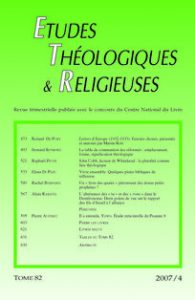La Réformation a entraîné un changement significatif du mobilier liturgique : du côté luthérien,réduction des nombreux autels médiévaux à un seul ; du côté réformé, remplacement des autels par une table de communion.Bernard Reymond passe en revue les principales manières de concevoir la célébration réformée de la Cène et le mobilier qu’elle requiert à l’époque classique (XVIe-XVIIIe siècle), puis examine les variations qui ont affecté la table et son emplacement de l’âge romantique à nos jours, pour terminer par un coup d’oeil critique sur les modifications entraînées par le « renouveau liturgique » du siècle dernier.
In the wake of the Reformation, liturgical furnishings used for Communion changed significantly: the Lutherans kept only one altar whereas the Reformed Protestants abandoned altars for a simple table. Bernard Reymond reviews the main ways the latter envisioned the celebration of Communion and the types of tables used during the classical period (16th to 18th century). Then he examines the modifications of their location, form and theological significance from romanticism up to today, and concludes with a critical approach of the changes brought about by the « liturgical renewal » of the twentieth century.
p. 493-520
Auteur
REYMOND Bernard
Bernard REYMOND est professeur honoraire de théologie pratique à la Faculté de théologie et de sciences des religions de Lausanne.
